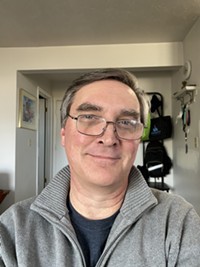Lost Souls
Two artists collaborate on a vision of connecting with those who are no longer with us.
By Scott Renshaw @scottrenshawThroughout two years of pandemic, we've learned a lot about the many different ways people can be connected even when they're apart. For an art exhibition that explores themes of separation and reunion, it's fitting that the creative process involved a cross-country collaboration.
This week, the Utah Museum of Fine Arts' ACME Lab opens Transcending Time and Space, which presents multi-media pieces by New York-based artist David Rios Ferreira complemented by work and writing by Utah-based artist Denae Shanidiin. Focused around Ferreira's images of portals made up of images from popular culture, children's coloring books and other sources, the exhibition explores the idea of connecting with lost loved ones, linked directly to the issue of missing and murdered indigenous women for which Shanidiin works as an advocate.
It was something of a necessary collaboration, as Ferreira describes it, because it was important to him to fulfill the ACME Lab's mission of making art that connects with the local community. When he was invited by UMFA's Jorge Rojas to create an exhibition, Ferreira needed to consider how he, as a life-long New Yorker, could connect to Utah. "I was really reflecting on my place in Utah, a space I've never been," he says. "So in doing the research, I was really attracted through the indigenous presence [in Utah]. And what starts to spiral is, 'Okay, there's that interest, but what next?'"
What was next was Rojas introducing Ferreira to Shanidiin. And according to both artists, the sense of interconnection was immediate, with Shanidiin recognizing the respect for and understanding of indigenous issues Ferreira brought to the table from his own Puerto Rican heritage. "All indigenous people are displaced, in one way or another," Shanidiin says. "It's the same, same-same but different. We share that same memory in our bodies and in our stories."
That sense of shared experience extends to a discovery Ferreira made about the link between white American teachers of indigenous children in the 19th and early 20th centuries, and white American teachers of Puerto Rican children when the island became a U.S. territory. "They planted U.S. reps in public schools, to basically try to obliterate Spanish culture," he says. "All those strategies came from teachers who had worked in the boarding schools [for indigenous children]. At first [in Puerto Rico], they used the military. But then they realized, they had already done this. They would ship the teachers [from the boarding schools] over, and these same teachers were teaching [in Puerto Rico]."
For the UMFA exhibit, Ferreira developed early on the idea of portals, in a kind of science-fiction narrative about being able to connect immediately with absent loved ones. "I was thinking about all this loss," he says, "not through a lens of sadness ... but that we might reach them—not just someday, but today."
As he began to share the images with Shanidiin, she provided feedback that offered a different perspective on the work. "For me, it was enlightening to see what was coming through," Ferreira says. "I almost think about my creation in a very spiritual way, even though I'm using lines and cartoons. Some of these images have tough histories, and it's nice to hear someone pick up on some of that."
"His portals just made sense to me, in the way we think of indigenous people with interwovenness," Shanidiin adds. "When you do lose somebody, it creates that fracture in the universe. [Ferreira] just gets it; we got it together."
"Getting it" can be a big issue in the world of contemporary art, as Ferreira recognizes. Since the ACME Lab space is one that invites attendees to participate in and contribute to the exhibit experience—in this case, by sharing their own messages to loved ones, among other participatory opportunities—it was important that the emotion of the theme override some need to "decode" the work.
"When you think about contemporary art, there's a lot of academia surrounding that practice," Ferreira says. "It was good to just think about love, and spirituality through art. ... All too often, people think with contemporary art, 'Do I get it?' They say something to you and it's like, 'Is that right?' It's not a game of Clue. There's no 'win.' If anything, the win is that maybe you've thought more about what I've just shared with you."
That sharing connects with the reality of ongoing violence faced by indigenous people, and it was clear to Shanidiin that Ferreira showed sensitivity in delving into that subject. "Those realities are not fairy tales; they're very real, but they've been hidden and tucked away violently, with the utmost intention to erase us," she says. "Navigating [that subject] now in a way of beauty just feels really good. ... I really trust [Ferreira] with what he's saying. This connection feels like something I personally needed."
More by Scott Renshaw
-
Film Reviews: New Releases for May 30
Karate Kid Legends, Bring Her Back, Jane Austen Wrecked My Life, Bad Shabbos, Tornado
- May 29, 2025
-
JANE AUSTEN WRECKED MY LIFE, BRING HER BACK, June 2025 Special Screenings
Two new releases, plus SLFS Summer Showdown, Wild & Scenic Festival and more.
- May 28, 2025
-
Film Reviews: New Releases for May 23
Lilo & Stitch, Mission: Impossible - The Final Reckoning, Friendship, Fountain of Youth, The Last Rodeo
- May 22, 2025
- More »




